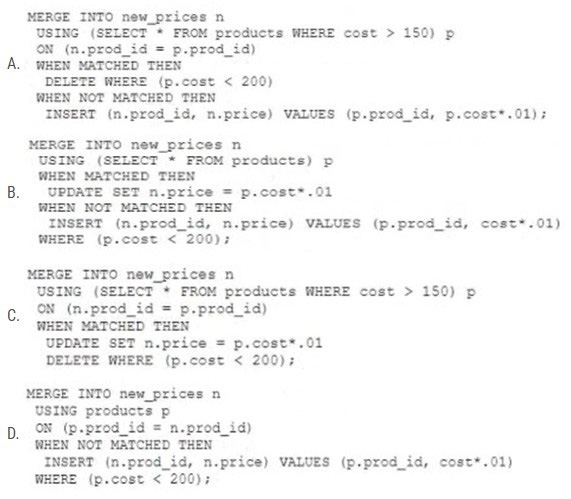Exam Details
Exam Code
:1Z0-071Exam Name
:Oracle Database SQLCertification
:Oracle CertificationsVendor
:OracleTotal Questions
:415 Q&AsLast Updated
:Mar 28, 2025
Oracle Oracle Certifications 1Z0-071 Questions & Answers
-
Question 341:
Which three statements are true about single row functions?
A. They can be used only in the where clause of a select statement.
B. They can accept only one argument.
C. They return a single result row per table.
D. The argument can be a column name, variable, literal or an expression.
E. They can be nested to any level.
F. The date type returned can be different from the data type of the argument.
-
Question 342:
Examine the description of the PRODUCT_INFORMATION table:

Which query retrieves the number of products with a null list price?
A. SELECT COUNT(NVL(list_price, 0)) FROM product_information WHERE list_price is NULL;
B. SELECT COUNT(list_price) FROM product_information WHERE list_price = NULL;
C. SELECT COUNT(list_price) FROM product_information WHERE list_price IS NULL;
D. SELECT COUNT(DISTINCT list_price) FROM product_information WHERE list_price IS NULL;
-
Question 343:
Examine the description of the PRODUCTS table:

You successfully execute this command:
CREATE TABLE new_prices (prod_id NUMBER(2), price NUMBER(8,2))
Which two statements execute without errors? (Choose two.)

A. Option A
B. Option B
C. Option C
D. Option D
-
Question 344:
Which two are true about the MERGE statement?
A. The WHEN NOT MATCHED clause can be used to specify the deletions to be performed.
B. The WHEN NOT MATCHED clause can be used to specify the inserts to be performed.
C. The WHEN MATCHED clause can be used to specify the inserts to be performed.
D. The WHEN NOT MATCHED clause can be used to specify the updates to be performed.
E. The WHEN MATCHED clause can be used to specify the updates to be performed.
-
Question 345:
Examine the description of the EMPLOYEES table:

Examine this query:

Which line produces an error?
A. Line 7
B. Line 8
C. Line 3
D. Line 5
-
Question 346:
Examine this list of queries:

Which two statements are true? (Choose two.)
A. 1 and 4 give the same result.
B. 2 returns the value 20.
C. 2 and 3 give the same result.
D. 3 returns an error.
E. 1 and 4 give different results.
-
Question 347:
The STORES table has a column START_DATE of data type DATE, containing the datethe row was inserted.
You only want to display details of rows where START_DATEis within the last 25 months.Which WHERE clause can be used?
A. WHERE TO_NUMBER(start_date - SYSDATE)<=25
B. WHERE ADD_MONTHS (start date , 25)<= SYSDATE
C. WHERE MONTHS_BETWEEN(SYSDATE, start_date)<=25
D. WHERE MONTHS_BETWEEN (start_date, SYSDATE)<=25
-
Question 348:
You create a table by using this command:
CREATE TABLE rate_list (rate NUMBER(6,2));
Which two are true about executing statements?
A. INSERT INTO rate_list VALUES (0.999) produces an error.
B. INSERT INTO rate_list VALUES (-.9) inserts the value as -.9.
C. INSERT INTO rate_list VALUES (87654.556) inserts the value as 87654.6.
D. INSERT INTO rate_list VALUES (-10) produces an error.
E. INSERT INTO rate_list VALUES (-99.99) inserts the value as 99.99.
F. INSERT INTO rate_list VALUES (0.551) inserts the value as .55.
-
Question 349:
Which two statements are true regarding indexes? (Choose two.)
A. An update to a table can result in updates to any or all of the table's indexes.
B. An update to a table can result in no updates to any of the table's indexes.
C. A UNIQUE index can be altered to be non-unique.
D. When a table is dropped and is moved to the RECYCLE BIN, all indexes built on that table are permanently dropped.
E. A table belonging to one user cannot have an index that belongs to a different user.
-
Question 350:
Which two are true about the USING clause when joining tables?
A. All column names in a USING clause must be qualified with a table name or table alias.
B. It can never be used with onatural join.
C. It is used to specify an equijoin of columns that have the same name in both tables.
D. It can never be used with a full outer join.
E. It is used to specify an explicit join condition involving operators.
Related Exams:
1Z0-020
Oracle8i: New Features for Administrators1Z0-023
Architecture and Administration1Z0-024
Performance Tuning1Z0-025
Backup and Recovery1Z0-026
Network Administration1Z0-034
Upgrade Oracle9i/10g OCA to Oracle Database OCP1Z0-036
Managing Oracle9i on Linux1Z0-041
Oracle Database 10g: DBA Assessment1Z0-052
Oracle Database 11g: Administration Workshop I1Z0-053
Oracle Database 11g: Administration II
Tips on How to Prepare for the Exams
Nowadays, the certification exams become more and more important and required by more and more enterprises when applying for a job. But how to prepare for the exam effectively? How to prepare for the exam in a short time with less efforts? How to get a ideal result and how to find the most reliable resources? Here on Vcedump.com, you will find all the answers. Vcedump.com provide not only Oracle exam questions, answers and explanations but also complete assistance on your exam preparation and certification application. If you are confused on your 1Z0-071 exam preparations and Oracle certification application, do not hesitate to visit our Vcedump.com to find your solutions here.